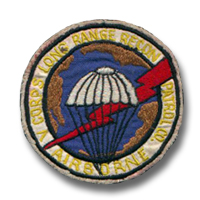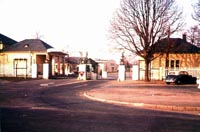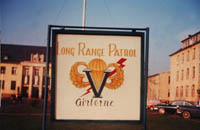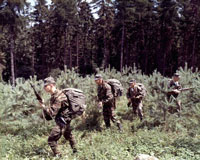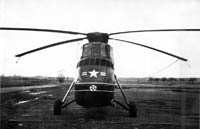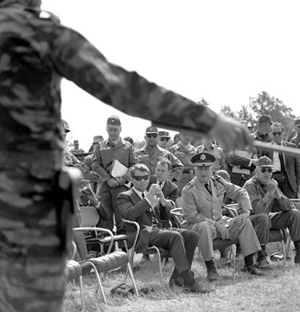| If you do
NOT see the Table of Contents frame to the left of this page, then
Click here to open 'USArmyGermany' frameset |
||||||||||||||||||||||||||||||||
|
V
Corps Special Troops |
||||||||||||||||||||||||||||||||
|
|
||||||||||||||||||||||||||||||||
|
||||||||||||||||||||||||||||||||
|
|
||||||||||||||||||||||||||||||||
| V Corps Special Troops Battalion | ||||||||||||||||||||||||||||||||
| (Source: Email from Norm Newhouse, Special Troops, 1962-65) | ||||||||||||||||||||||||||||||||
I served (as a 1LT) with Special Troops, V Corps,
1962 -65. Back then Special Troops was a pretty big battalion with
the following units:
All units were
barracked at Gibbs. Along with the 45th Medical Battalion which
was part of 3rd Armored Division. Obviously no aircraft were at
Gibbs. I do not recall the name of the airfield. But it was not
far away. Just north of Drake-Edwards Kaserne as I recall. (The
City of Frankfurt is turning Gibbs into a new emergency center for
the fire department.) |
||||||||||||||||||||||||||||||||
| 69th Engineer Company (TOPO) | ||||||||||||||||||||||||||||||||
| 332nd Engineer Company (TOPO) | ||||||||||||||||||||||||||||||||
| 1951 - 1954 | ||||||||||||||||||||||||||||||||
| 569th Engineer Company (TOPO) | ||||||||||||||||||||||||||||||||
|
||||||||||||||||||||||||||||||||
| 1954 - 1955 | ||||||||||||||||||||||||||||||||
| (Source: Lineage And Honors Information, US Army Center of of Military History webiste) | ||||||||||||||||||||||||||||||||
Activated 3 December 1954 in Germany Inactivated 19 December 1955 in Germany |
||||||||||||||||||||||||||||||||
| (Source: STARS & STRIPES, Feb 25, 1955) | ||||||||||||||||||||||||||||||||
| The 569th Engineer Topographic Company is a mobile unit that organizes, revises, reprints and distributes maps. The unit is also capable of making original map compilations. The company produced and distributed more than 2 million impressions in 1954. The 569th was activated in Dec 1954, assuming the mission, personnel and equipment of the 332nd Engr Co (Topo), a US Army Reserve outfit that was inactivated at the same time. (The 332nd Engr Co had been ferealized and moved to Germany in 1951 as part of the build-up of American forces in Germany during the Korean conflict.) The 569th is divided into four sections: Headquarters Platoon is responible for administration, supply and operating the motor pool for the company. Hq Pltn also comprises a Map Distribution Section which disseminates maps to V Corps units upon request. Survey Section keeps maps up to date through constant feld surveys. Photomapping Platoon is responsible for revising exisiting maps. The platoon has the equipment to compile original topo maps and also to compile overlays for corps field exercises and maneuvers. Reproduction Platoon is equipped with three portable field presses for the reproduction of new maps and reprints of existing ones. It can also produce required overlays for field exercises. The tactical maps (scaled from 1:25,000 to 1:100,000) that the platoon prints can be as large as 22x29 inches. Another important function of the company is to convert German topo maps (produced by German Land Survey Offices) for Army use. The effort includes converted grids, projections, and military symbols to conform with standard US Army map style. |
||||||||||||||||||||||||||||||||
| 69th Engineer Company (TOPO) | ||||||||||||||||||||||||||||||||
| 1955 - 1969 | ||||||||||||||||||||||||||||||||
| (Source: Email from Eddie Gibbs) | ||||||||||||||||||||||||||||||||
I was in the 69th Topo from 1-1959 – 2-1961. The NCO and EM club was directly across the street from our barracks; the NCO club was on the bottom floor and the EM club was upstairs. On the top floor of our barracks was, if I remember right, the 32nd Signal. My last name is Gibbs and I never had a problem with my name until I got short and some of the Officers from the other companys thought I was being a smart ass by putting the Kaserne’s name on my fatigues. I hope this will provide you some insight into the 69th Topo. |
||||||||||||||||||||||||||||||||
| In 1969, the 69th Engr Co (Topo) was (possibly) inactivated and its assets moved to the 656th Engr Bn (Topo) in Heidleberg. | ||||||||||||||||||||||||||||||||
| 85th Transportation Company (Lt Trk) | ||||||||||||||||||||||||||||||||
| 1972 | ||||||||||||||||||||||||||||||||
| (Source: Email from Gerald Keating, 85th Trans Co, 1972-1974) | ||||||||||||||||||||||||||||||||
| I was assigned as a platoon leader to the 85th Trans Company in 1972, a TOE (versus TDA) transportation unit. The unit had (2) 2.5-Ton platoons and (1) 5-Ton platoon. Also a headquarters section and platoon for mechanics/bobcat drivers. Probably around 130 members. The timeframe was not favorable because of the Viet Nam war drawdown, drug use, and strained relations with the Frankfurt civilian community.
The 85th was located on the 3rd floor of Bldg. 403. At that time, the 92nd Trans (Sedan) was located on the 2nd floor. At the time, the 92nd enjoyed some notoriety because its platoon leaders were also trained as lawyers, and would eventually be transferred to V CORPS JAG. If my memory is correct, Bldg. 402 was occupied by the HHC V COSCOM. It was a large unit since its EM staffed the IG Farben Bldg. At that time, the 4th floor was reserved for unaccompanied NCOs above E-6. Bldg. 401 was housing for HHC V CORPS and its MP Platoon. Bldg. 418 housed the V COSCOM Data Processing Company and the V COSCOM Materiel Management Company. The basements of Bldgs. 402 and 403 were used as company arms rooms, supply rooms, NBC equipment rooms etc. The 4th floor of Bldg. 418 was quarters for the guest worker KPs. Because of the VOLAR initiative at the time, GIs were no longer pulling KP. The mess hall was located in Bldg. 404A. The units in Bldgs. 402. 403, and 418 were V COSCOM units, and tended to work together such as for property book transfers, report of surveys, police call etc. The 85th often became the home for 92nd drivers who did not work out as sedan drivers for VIPs. I remember the weekly QM laundry run to Marburg was staggered, so that the 85th loaded up and drove on Monday mornings, with the other units following suit on alternate days. Bldg. 412 was used for unit classrooms, and at one point had an EM bar. There used to be a small concrete bldg. around Bldg. 413 where you pulled your TA-50 back then. Bldg. 417 was HQ, Special Troops Bn. The gym/bowling alley was in Bldg. 408A. Bldg. 405 contained an AFFES movie theater, dry cleaning/tailor shop, shoe repair, barber shop, and snack bar. On the 2nd floor were craft shops etc. There were no volley ball courts. At that time, the drill field was sand covered, and was used for morning PT. There was a guard mount each day, occupying Bldgs. 414, 415, and 445. It was during/after the Bader-Meinhof bombings, so each guard mount carried a magazine of three rounds. The guard mount was assembled and assigned in strict accordance with FM 22-6. The OG had the unpleasant task of coaxing the 1950s era Wollensack reel-to-reel recorder to play Reveille, Taps etc. As I recall, Bldg. 407 was the motor pool for the 85th Trans., and Bldg. 406 was for the 92nd Trans. It was said that these buildings were used by the German cavalry pre-WWII. I recall that at the time, the 92nd used one-half of an OD green GI bus that was cut in half as its dispatch shed. It was definitely an eye sore to the citizenry because it was visible on Marbachweg. As was the case mentioned for the 92nd Trans, the 85th Trans was also unceremoniously deactivated in September 1972. The deactivation was classified secret until July 1972. There was no time to properly transfer the property book or to conduct a unit fund audit etc. GIs with less than 180 days received a pleasant surprise because they were discharged. Those less fortunate ended up with the 181st Trans Bn. in Mannheim, at that time, Coleman Barracks. A lucky few ended up as reefer drivers for TASCOM. This was considered a plum assignment because it was all Autobahn travel in a civilian Ford Semi, hauling PX merchandise on the Bremerhaven to Frankfurt run. It was also beneficial because TASCOM was a three-star command, and its drivers enjoyed the resulting perks not found in a one-star COSCOM command. As was mentioned for the 92nd Trans, the Army leadership did a disservice to the many drivers and mechanics in the unit. Some of the 2.5-ton trucks were Korean War vintage, and would fail V COSCOM roadside spot inspections immediately after organizational, Level 1 maintenance had been performed. This resulted in the unit’s entire chain of command having to attend Saturday morning remedial classes. Some of the 5-Ton drivers were seldom seen because they were constantly on commitment, often sleeping in the truck because no kaserne barrack housing was available. Many of the drivers were draftees, performing the necessary but mundane transportation duties required of a support command, for which they were neither thanked nor recognized. |
||||||||||||||||||||||||||||||||
| 92nd Transportation Company (Car) | ||||||||||||||||||||||||||||||||
| 1968 | ||||||||||||||||||||||||||||||||
| (Source: STARS & STRIPES, March 1, 1968) | ||||||||||||||||||||||||||||||||
| The 92nd Trans Co (Car) is a V Corps unit tasked with providing transportation for personnel from V Corps headquarters and also serving as a backup to Com Z's transportation unit in Frankfurt (HQ Trans Comd, COMZ in Oberursel?). The car company also has 12 personnel and 10 sedans attached to the 2nd Support Brigade headquarters. Car companies are assigned only to headquarters of corps or larger commands. Divisions and other smaller units have car squads from transportation companies assigned to them. According to the article, there are three such car companies (incl. the 92nd) in USAREUR. However, the USAREUR STATION LIST for 15 Oct 1968 shows four: Only one-third of the 92nd's vehicles are sedans -- the other two-thirds are jeeps and ¾-ton trucks. Assignments are given by the company's Dispatch Office. Sedans and other vehicles re dispatched on a priority basis. The passenger's mission and the number of miles he must travel to fulfill that mission are important criteria for considering assignment of a vfehicle. 1st LT Terry O. Phillipson is the company CO. |
||||||||||||||||||||||||||||||||
| 1981 | ||||||||||||||||||||||||||||||||
| (Source: Email from Bob Foster, last CO of the 92nd Trans Co (Car), 1981-1982) | ||||||||||||||||||||||||||||||||
| I read your website today, specifically in reference to the 92nd Trans Co (Car).
I commanded that unit from December 1981 until its inactivation on 15 September, 1982. At the time, it was assigned to the Special Troops Bn of the 3rd Support Command (much later to become the 3rd COSCOM). It was still at Gibbs Kaserne and had the same mission as stated on your website: that of providing the “wheels” for the V Corps staff, as well as to the 3rd SUPCOM staff. At the time of our inactivation, we had a platoon of Ford Mavericks, a squad of VW Vanagons attached to that platoon, a platoon of M151A1s and A2s, and a cargo platoon of M880s (Dodge RAM pickups). For the platoon and attached squad that operated the non-tactical stuff, there was an equipment set of M151s maintained in Hanau, in “long term storage”. Even though we had a full year’s advance notice that we would inactivate on 15 September 1982, we kept getting replacements until the 1st of September 1982. We even got “commitments” for drivers and vehicles from HQs, V Corps a week before our inactivation, for missions AFTER our inactivation. V Corps wasn’t pleased when we declined, indicating we would no longer exist after the 15th. We had been provided zero guidance on who would perform our mission after our inactivation, so we couldn’t even refer them to anyone. Inactivations were rare for that timeframe, and there was virtually no guidance anywhere regarding our inactivation. I, my Supply Sergeant, and my Maintenance Tech were tasked to “find a home for our equipment”. If there were an E-Bay or Craigslist at the time, it would have probably been listed there. Soldiers were transferred throughout the 3rd SUPCOM (mostly to the 181st Trans Bn in Mannheim) – usually with only one day’s notice, and some (like me) just stayed at Gibbs doing odd-jobs until we PCS’d. For me, I was slotted as the 3rd SUPCOM Special Troops Bn S-4 but really operated as the assistant Bn XO and S2/3 adviser until I left in December for CONUS. To me, it was a shameful end to a great, honorable company. My Maintenance Warrant, CWO Frank Valleca, had served in just about every position in that company short of platoon leader and commander. Most of his career was in that company. As sad as it was for me to inactivate the company, it was heartbreaking for him. He was able to read the inactivation orders at the inactivation ceremony, but his voice faltered several times. When I think of that company, I think of Frank. The Military History folks expressed no interest in any of the company’s unit-specific heritage-related gear. I was told by the CMH that if I sent the company guidon and its five WWII campaign rings, they would go in the trash. So, I still have them as well as all of the company’s partnership mementos, plaques, certificates, etc. I had been saving them in the event that someday, the Army would activate a transportation company designated as the 92nd, and then I would send all of this to the new commander. That hasn’t happened yet, and probably never will. The “parking lot bituminous” to the left of building 410 was the motor park for HQs, V Corps, with buildings 408 and 409 being their maintenance bays. For the life of me, I can’t recall what bldgs 406 and 407 were used for, but I suspect one of them housed the maintenance bays for the MPs. I cannot say for certain where the consolidated dining facility was, but am pretty sure it was in either bldg 406, 407, or 409A. Somewhere in that area and I’m inclined to think it was 409A just because of the orientation. I don’t recall the “gas filling station” (A1) being where it was indicated on the image (to the left of the PX, between 405 and 406), but I may be wrong. My recollection was that it was in the lower left hand corner of the image somewhere. There was no AAFES gas station there. The Frankfurt area PMO was located in bldg 417. The vehicle impoundment lot was behind it as well as a little to the right. I have no idea what bldg 413 housed, but it seems to be about the right location for the POL point. I have no idea what bldg 404A housed. I suppose it is remotely possible that 404A was where the dining facility was but I have a pretty firm recollection it was in the area of/around bldg 409A. I believe the maintenance bays for HHC, 3rd SUPCOM, were in building 411 with their motor park to the left of it. It may have also housed what few vehicles the 19th MMC, 502nd MCC, and the 17th DPD had. The 17th DPD’s computers were in trailers behind the Abrams Bldg. The CIF was in bldg 412. The 19th MMC was located in bldg 404. HHC, 3rd SUPCOM had their offices, supply room, arms room, and billeted their soldiers in bldg 418. I don’t know for certain if soldiers from the 19th MMC, 17th DPD, and 502nd MCC were billeted there: it was either bldg 418 or 403. HQs, Special Troops Bn offices were on the first floor and part of the basement (S4 shop) in bldg 403. That is also where the 92nd had its company offices (second floor); arms room, NBC room, and supply room (basement); and is where its soldiers were billeted (2nd and 3rd floors). The 4th floor was the attic and not used. When I was there, the attic was declared a health hazard due to the copious amount of pigeon droppings. The flag pole was where indicated on the image you sent (in front of bldg 403). I’m not sure which is which, but HHC, V Corps had it offices, arms room, supply room, NBC room, billets, etc. in either bldg 401 or 402, with the MPs in the other bldg. The large “drill field gravel” indicated above bldg 403 was grass when I was there. It is where the 92nd Trans had its inactivation ceremony. Hope this helps. |
||||||||||||||||||||||||||||||||
|
|
||||||||||||||||||||||||||||||||
| V Corps LRRP | ||||||||||||||||||||||||||||||||
| (Source: Email from Bob Murphy, V Corps LRRP Co (Abn) 3779, 1964-67) | ||||||||||||||||||||||||||||||||
| THE FIRST
AND THE LAST LRRPS A SHORT HISTORY OF V CORPS LRRP-A/75 RANGERS 1961-1974 WILDFLECKEN, FRANKFURT/MAIN, FORT BENNING, FORT HOOD V Corps Long Range Reconnaissance Patrol Company, later Co. A, 75th Infantry (Ranger), was the longest serving DA authorized LRRP/Ranger Company in the US Army. The USA LRRP Co (Abn) 3779 was activated at Wildflecken, Germany by 7th Army on 15 JUL 61 to serve as V Corps LRRP Company in Germany. It was deactivated on 19 DEC 74 at Ft Hood as Company A, 75th Infantry (Ranger) where it was performing Long Range Reconnaissance Patrol work for the 1st Cavalry Division. The company was initially assigned to the 14th Armored Cavalry Regiment for administration and court-martial jurisdiction. At that time the company wore the 7th Army shoulder patch with blue and white Airborne tab and was the only unit near the East German border on jump status. The first Commanding Officer was Major Reese Jones and first 1st Sergeant was Gilberto M. Martinez. V Corps was deployed across the West German states of Hesse and the Bayern (Bavaria), facing four of the six most likely Soviet penetration corridors into West Germany. Company field training exercises included extensive patrols in the Bad Heisfeld-Giessen, Fulda-Hanau, Bad Kissingen -- Wurzburg and Coburg - Bamberg corridors to include rehearsals for deep penetration missions against Thuringian targets typically including Soviet Weimer - Nobra air installation and Army facilities around Ohrdruf and Jena. The Company would be used also for special missions of infiltration that included team placement of T-4 Atomic Demolition Munitions and locating enemy battlefield targets for Army tactical nuclear delivery systems. In autumn 1962 LRRP LT Robert C Murphy flew to England and purchased maroon berets for the company from his own funds. They were authorized for wear by the CG of 7th Army for both V and VII Corps LRRP Companies. The company crest was designed at that time by then Sgt Mike Martin and the motto "Cum Animus Et Successus" (Through Courage, Success) added by Murphy. Long range radio communications received a major boost with the issue of the AN/TRC-77 CW Radio to the Company in 1962. Civilian technicians from Sylvania trained LRRPs to use the new radios which served both V & VII Corps LRRPs faithfully until mid-1968. Few LRRPs knew there were six "burst coders" for the TRC-77s locked up in the company EDP (Emergency Defence Plan) safe with other classified equipment. The company moved to Edwards Kaserne outside of Frankfurt with Captain William Guinn assuming command from Major Edward Porter in January 1963. The shoulder patch was changed from 7th Army to V Corps with blue and white airborne tab. The company moved yet again on 9 MAY 63 to Gibbs Kaserne in Frankfurt and became part of the V Corps Special Troops (Provisional) working directly for V Corps G-2. General Creighton Abrams assumed command of V Corps in 1963 and revoked the company's maroon berets when he found out they had not been authorized by Department of the Army. 1964 saw the issue of AN/PRC-25s FM voice radios to replace the AN/PRC-10s with their infamously poor German-made batteries. Those batteries were so weak that it was often necessary to keep the radios in sleeping bags to keep them from going dead in cold weather. The change to PRC-25s was a major improvement and made it possible to communicate properly with both Army and Air Force aircraft for the first time. The company also traded in its M-14 rifles for the new "XM16E1" 5.56mm rifle in the autumn of 1964 (Yes, they had a high malfunction rate even when new in Europe, as well as RVN). The company was often assigned to Honor Guard duties in garrison during this period. It was chosen as an Honor Guard to represent the US Army Airborne at the 20th anniversary of the Normandy Invasion in France on 6 JUN 64 which it did with 122 enlisted men and four officers. C.O. Capt Norm Carlton even paid for the non-issue white gloves for the Honor Guard out of his own pocket on that occasion. Under Captains Guinn and Carlton, the V Corps LRRP's developed and perfected aspects of Long Range Patrol operations that resulted in the issue of the first LRRP TO&E (Table of Organisation & Equipment) 7-157E and the publication of the first Long Range Reconnaissance Company Field Manual, FM 31-16. The issue of the TO&E in 1965 saw the end of Provisional status for V and VII Corps LRRPs and the re-designation of both companies. The company name was officially changed to Company D, (LRP), 17th Infantry on 15 MAY 65 with the issue of the new TO&E. The company continued with the same personnel, mission, barracks, and continued to wear its unique crest. But the TO&E did result in an increase of authorized strength to 208 men, 24 five man patrols (formerly four man), and a new transportation section (the company formerly used 2.5 ton trucks from the 35th Transportation Company located in the same barracks at Gibbs Kaserne. Who could forget "Romeo" the bespectaled truck driver who fell hopelessly in love with everything in a skirt and once got hypnotised by the windshield wipers on his own truck and had to be brought to by the LRRP riding shotgun as he started to run off the road?). The TO&E also formalized the trend towards Ranger status with a requirement for 24 Patrol Leaders, three "Killer" Platoon Leaders, the Ops Officer, Exec Officer, C.O. and 1st Sergeant to be Ranger qualified. All 208 LRRPs had to be parachute qualified. The company continued its constant training cycles of Soviet Order of Battle, camouflage, CW radio operator training, and frequent FTXs, most of them in winter but big changes were happening in the Army as the Vietnam war escalated. In 1967 popular C.O. Charlie Wertenberger announced a "levy" of the company for Vietnam. Carl Mancini recalls, "When Khe Sanh got hit (Marines and 173rd) they had a levy come down for airborne personnel. The C.O. got the entire unit down to the theater and told us what was going on. He made the married personnel and the people who were short leave. That left about 60 guys and they need 50 so he asked for volunteers. He got killed after about three weeks in country but to me he was a great guy. I looked him up at the wall." In 1968, the Army began a massive pullout from Europe as part of a mutual reduction of forces with the Warsaw Pact. It was code named " OPERATION REFORGER ". (Redeployment of Forces Germany) and the company relocated from Frankfurt, Germany to Fort Benning Georgia in July, with Captain Harry W. Nieubar as the company commander. The Ft Benning barracks was on Kelley Hill and the company was the only active duty Airborne unit on the post. They still wore the V Corps patch with airborne tab and were used as Aggressors at all three Ranger Training sites. "Our patrols used to make life miserable for the students", Terry Roderick recalls. "And we had legg outfits all around us on Kelley Hill and we thought we owned the place." Commanding Officers there included Thomas P Meyer and Dennis Foley. About half of the company consisted of Vietnam combat veterans at that time, most of them from the 101st and the 173rd. The company also ran the RVN Orientation at Ft Benning. Walter Buchanan says the Orientation gave the troops opportunities to run obstacle courses including a rope bridge built by another LRRP, Daniel Pope. Half of the troops would fall off the bridge and the Captain would say, "Congratulations. You've just passed the Orientation", and tell them to always remain on their toes in 'Nam and expect the unexpected, never drop their guard. Then they would all get in the back of their trucks and head for the barracks. "We used to ambush them on the way home in the back of the deuce and a halfs", Walter says. "We used a LOT of det cord and artillery simulators on them." Walter and Daniel later did a 'Nam tour together in C/75. The company also assisted Indiana National Guard LRP Company D/151 to get ready for Vietnam in 1968. Calvin Everhart remembers about a dozen who were short timers or otherwise ineligible to go who stayed in D/17 when D/151 left for 'Nam. The company had left its long range AN/TRC-77 Morse Code radios behind in Germany and carried only AN/PRC-25s in the field. CW capability rapidly atrophied until 10 LRRPs were sent to Ft Jackson for CW training at the end of 1968. By that time, D/17 was training for both European and RVN operations and then the Army added Riot Training. The latter caused some spectacular events which made the Army re-think LRRP suitability for crowd control and that task was dropped. FTXs supported the RVN mission and in 1969 the company began sending trained LRPs to other LRP Companies in Vietnam weekly. By this time the company was fielding six man teams as had become standard practice in RVN. Co D, LRP, 17th Inf underwent a name change to A/75 Rangers on 1 FEB 69 with Captain Thomas P. Meyer as Commanding Officer. There was no ceremony according to several people who were there. Ranger unit crests were issued and the company was required to adopt a 197th Infantry Brigade shoulder patch with Airborne tab and a new jump wings background. Despite those changes, the company retained its REFORGER mission as V Corps LRRP and that is the main reason why it was never deployed to Vietnam. A/75 was now a Ranger company but it had very few tabbed Rangers and it stayed that way. "It was a sore spot, but the company just could not get the training slots", Terry Roderick remembers. "Here we were, the big Ranger company at Ft Benning, but we weren't Rangers, we were LRPs. It was a crock and we knew it." One benefit of being at Ft Benning was proximity to the jump and Pathfinder schools and many A/75 people made "recreational jumps" at the schools. But most of the guys who had served in Vietnam had not jumped in more than a year. Many had never even made their cherry jump. Richard McClung was assigned to the company after his Vietnam tour and recalls that when he reported in July 1970, he was pencilled in for a jump on Rapido DZ. He asked when his refresher course was and 1st Sgt Vick replied, "When make your jump, Stud." A/75 transferred from Ft Benning to Ft Hood early in 1970, arriving on February 3 under the Command of Captain Johnathan Henkel and was assigned to the 1st Armored Division. The primary mission until June 1972 was to support MASSTAR (Mobile Army Sensor Systems Test, Evaluation, and Review ). The program dealt with surveillance, target acquisition, seismic intrusion detector and night observation equipment which paved the way and benefited the Army in its performance in the Gulf War twenty years later. The job wasn't as dull as it sounds because the company was mostly used in an Aggressor capacity against troops using the test devices. The mission changed again in July 1972, to provide Long Range Reconnaissance capability for the First Cavalry Division. The secondary mission was to stay in a high state of training for the original mission of V Corps LRRP. A/75 did, in fact, deploy to Germany on an annual Reforger exercise in 1973 to do exactly the same work as their predecessors did in the early and mid 60s. By that time more than 80 percent of A/75 personnel were Vietnam Veterans. 1974 was the beginning of the end for A/75 with the new Ranger battalions forming around a nucleus of key people, many of them former A/75 members. The 1st Ranger Battalion sent former A/75 CO Captain Clark and former A/75 1st Sergeant Romo to the company and they recruited a lot of company personnel who left in mid-1974. Second Battalion CO LTC A.J. Baker also came to Ft Hood with his CSM and recruited another 2 or 3 dozen guys. The company was deactivated and its guideon cased for the last time at a fixed bayonet parade on 19 DEC 74. The last A/75 Commanding Officer was Captain James P. Fitter and last 1st Sergeant was Gary Carpenter (later to become the first Regimental Sergeant-Major of the 75th Ranger Regiment). Alan Campbell who was in A/75 at its deactivation and then went to 2nd Ranger Battalion sums up: "A/75 was a great unit. Times were wild. I still can't believe some of the stuff we did. I'm amazed that no one went to jail. Even some of the officers would have qualified as brigands. Still, we did our jobs better than anyone on Ft Hood." |
||||||||||||||||||||||||||||||||
|
|
||||||||||||||||||||||||||||||||
|
||||||||||||||||||||||||||||||||
|
|
||||||||||||||||||||||||||||||||
| (Source: Email from Richard Cole) | ||||||||||||||||||||||||||||||||
| I was in Germany from November 1959 through 1962. I went with a LRP patrol in Dec 1959 at Kirch Göns, Combat Command "A". We had two patrols and were attached to the 36th Infantry. Attended LRRP School in Spring of 1960. They formed this company, "V Corps Provisional LRRP Co", in Wildflecken in October of 1960 to train for Wintershield II to test the feasibility and to form a company, rather than have patrols scattered over Europe. We had patrols from the 36th Inf, 3rd Inf Div, Cav units, etc. We were not TOE, but our efforts paved the way for LRRP companies that were formed in Europe in 1961. After Wintershield II we returned to our units where we continued our assignments as LRRPs, even though they started to form companies. My time was getting short, so I returned to "the land of the round door knobs." |
||||||||||||||||||||||||||||||||
| (Source: The Guardian, Jan 14, 1961, via Richard Cole) | ||||||||||||||||||||||||||||||||
| The eyes and ears of V Corps move on little cat feet. The Long Range Reconnaissance Company could set themselves up on your front lawn, stay all day, and you'd never know they were there, all the time they'd be radioing your every action, including your dinner menu, back to their base camp. | ||||||||||||||||||||||||||||||||
|
||||||||||||||||||||||||||||||||
| Franklin's whole patrol is drawn from various Troops of the 7th Cavalry. The highly selected personnel of the Long Range Patrol are drawn from 80 separate companies throughout V Corps. Nearly thirty Long Rangers, from private to sergeant first class, were asked individually whether, all things being equal, they would re-up for the LRRP if they could. Every single one gave an unqualified affirmative. The reasons they gave bear a striking similarity. One consistent theme is the quality of the officers and noncoms. "The officers here treat you man to man," says Pfc John S. Raykowsky. Speaking of his company commander, Major George R. Jost, he added, "He knows his business. When he wants something, he doesn't hesitate to get it. He's all for his men and officers." Raykowsky sums up the atmosphere as "morale, friendship, good treatment." The word "morale" eventually turns up, unbidden, in every interview. Major Jost, himself, admiringly says, "This is the most gung-ho outfit I've ever seen." Pvt William D. McClure puts his feelings about his CO, Mai George R. Jost, another way: "Maj Jost is always out with the men. He always wears his field pants." Maj Jost was in reconnaissance work during WW II in Germany and led patrols in Alaska and Korea. Sergeants and enlisted men live, sleep, eat together, each patrol leader with his own men. This familiarity breeds no contempt, for the noncoms command mutual respect. They know their jobs and they lead rather than push. A good half of them draw proficiency pay. "He knows what he's doing in the field. If not for him, we'd probably be lost still," says Sp4 Edward E. Smith of his patrol leader, Sgt Wayne O. Knowles, on the escape and evasion problem. He adds, "it was one of the most realistic problems I've been on since I come into the Army. I learned a lot. It gave me an idea of what a small group of men out there alone could do in real combat." "The Aggressors were on our backs a lot. One of them lacked about a foot stepping on my head. We stuck to the hills most of the time, moved at night, slept during the day," said Smith, describing his patrol's methods. Pvt William D. McClure and another man were split from their patrols by Aggressor harassment three hours after the problem started. They teamed up and made it to the final pick-up point without a compass. Says McClure, "You're out there on your own. You just have to use your common sense in the cold. The whole thing kind of gave me an idea of what a wild animal feels like when he's being chased." Preparations for the problem took a month. At the last moment, the men were told it was canceled, that they would go out for the day on a routine radio exercise. At the start point they sent their radios back on truck and started out after a short briefing. They were given maps in wax-sealed envelopes to be opened only in an emergency. The course was only 20-km as the crow flies but stretched out to 40 with the azimuths the patrols were given. "We were hit by a scout jeep, as soon as we left the start point," recalls Pfc Michael J. Taylor. The patrol, under Sgt Robert D. Swank, was crossing a bridge when the jeep opened up with its 30-cal. from 1000 yards. It chased them overland seven km out of their way. They gave it the slip into the woods only because it foundered in the snow for a few minutes. The snow was on the side of the Aggressors, however. It made tracking relatively easy and slowed down the Long Rangers as they tried to brush away their tracks. Nevertheless, only seventeen men were caught. They were made captive only when they violated the first rule when operating in hostile territory: Avoid roads and built up areas. Anything legal was part of the game, so long as the patrol was not caught at it. In the town of Geroda, Sgt Lawrence A. Dearborne's patrol used a friendly German as a scout. He walked ahead of them and warned them back every time a military vehicle approached. Those taken prisoner in the stockade acquitted themselves well too. Wearing the forest green uniform and red headband of the Aggressors, B Co, 1 BG, 30th Inf organized an elaborate set-up complete with interrogation tent, barbed wire compound, and wall lockers to simulate coffins. All kinds of harassments combined with tempting inducements were used to make the captives talk. None did. Pfc John S. Raykowsky was caught the first evening of the problem. He was held for fifteen hours with no sleep, food, or cigarets. Offered a sleeping bag, coffee, and a map to proceed on the problem in exchange for information, he refused through four interrogations. Five or six times he was placed in a coffin. The Aggressor guards banged on the lockers, filled it with snow once, another time with a smoke bomb. At one point, Raykowsky, who had gone through a thorough shakedown, come out of the locker puffing on a cigar. Asked by the amazed guards where he had got it, he laughed, "Santa Claus brought it to me." Finally, Raykowsky was released with no rations, still managed to get to the final rendezvous point before the end of the problem. Patrol leader Sgt Walter G. Long summed it up, "It was a good problem, a little cold, though. There's a lot of morale on a problem like this. Any decision you make is your own, right or wrong." During the problem Sgt Long's patrol lived off its slim survival kit rations because the Aggressors threw them off their azimuth, preventing them from making checkpoints for reprovisioning. Of the men in the company he says, "Every guy that we have will try his best once he's out on patrol. The men have learned well." |
||||||||||||||||||||||||||||||||
| (Source: Stars & Stripes, European edition, Friday, June 26, 1964) | ||||||||||||||||||||||||||||||||
|
||||||||||||||||||||||||||||||||
| Related Links: 75th RANGER REGIMENT ASSOCIATION - very nice website also includes LRRP units assigned to V and VII Corps |
||||||||||||||||||||||||||||||||



